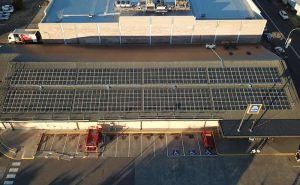The Federal Government’s Safeguard Crediting Mechanism proposes to establish a pilot ‘below-baseline crediting mechanism’ for large emitting facilities covered by the Safeguard Mechanism, commencing 1 July 2022.
The scheme would credit facilities that reduce their emissions intensity by undertaking ‘transformative’ abatement projects, with generated reductions differentiated from Australian Carbon Credit Units (ACCUs), referred to as Safeguard Mechanism Credits (SMCs).
Assuming the framework is implemented in its current form, we anticipate a range of potential implications for SMC prices, and Australia’s existing ACCU market, with newly created credits likely to trade at a discount to projects that capture and sequester carbon.
This is expected to result in the development of a two-speed price environment in Australia, with unit prices set in line with the differing value of underlying abatement and demand for each credit.
Should this occur, the development of a new industrial unit may reduce investment in Australia’s ACCU market, with potential for low-cost SMCs to become the primary tool for liable entities to manage excess emissions (and potentially meet voluntary commitments), resulting in lower demand for ACCUs.
In this article, we discuss the implications of the government’s proposed Safeguard Crediting Mechanism on Australia’s existing ACCU market, along with potential SMC-ACCU pricing and supply-demand considerations.
Findings are derived from our latest Carbon Market Outlook, presenting our quarterly scenarios for ACCU prices and supply-demand fundamentals between 2021-30.
Background to the Safeguard Crediting Mechanism
The Federal Government’s proposed Safeguard Crediting Mechanism seeks to move away from the underutilised Facilities method under the ERF, designed with strict additionality requirements, instead implementing a lower additionality threshold to encourage industry participation.
Facilities that reduce their emissions intensity relative to a historical baseline would be eligible to receive SMCs, with reductions calculated using data reported via the National Greenhouse and Energy Reporting scheme.
Crediting would require the facility to invest in ‘transformative’ low-emissions technologies, or undertake process changes that lead to emissions reductions, and would not occur simply because emissions are below a historical baseline, avoiding crediting due to reduced production or facility closures.
SMCs could be used to meet compliance obligations under the Safeguard Mechanism, be sold to other facilities that have exceeded their baselines (or to voluntary buyers), or be purchased by the Government via an auction process under the ERF.
A 5 year crediting period is proposed to be established, with time limits of 1-3 years on the use of SMCs proposed to apply during the trial period, aligning with monitoring periods for the Safeguard Mechanism. SMCs over a prescribed age may be cancelled, or be deemed ineligible for certain uses, such as their Safeguard surrender.
The government’s full discussion paper is available here.
Delivering genuine emissions reductions
How the government seeks to strike a balance between ‘genuine abatement’ and ‘commercial participation’ will be a key watch for local market participants, with policymakers likely to err on the side of encouraging industry take-up rather than more rigorous requirements for emissions reductions to be additional (which already exist under ERF’s Facilities method).
While the discussion paper proposes a range of ‘precautions’ to ensure emissions intensity improvements are genuine – such as discounting emissions reductions (SMCs could be issued for 85-95% of reductions delivered), minimum crediting thresholds, and a requirement for ‘transformation statements’ in support of projects – these mechanisms are expected to be designed so as not to be burdensome for industry.
For example, the discussion paper notes that, “transformation statements could provide transparency about projects, but should not increase the regulatory burden on businesses in a way that discourages them from undertaking the project.”
The King Review suggested that participants could be subject to a “duty of utmost good faith” making the statements – but a formal audit or verification may not be required.
In the absence of a crediting baseline which declines over time (for example aiming to reach net-zero, or account for improvements in efficiency year-on-year), the scheme is likely to run the risk of rewarding ‘anyway’ projects that represent business as usual (BAU) improvement in emissions intensity rather than genuine abatement (which we refer to as ‘grey credits’).
These grey credits have the potential to trigger windfall gains for industry, and lead to an influx of non-additional abatement supply into the market.
Although separate from ACCUs, this may impact the integrity of the Australian carbon market – and the validity of emissions reductions purchased by the Commonwealth – due to uncertainty over whether one SMC will equate to one tonne of CO2e reduced.
In addition, crediting reductions in emissions intensity may result in the perverse outcome of paying businesses to invest in projects which may increase absolute emissions, even if emissions intensity decreases (subject to new rules to restrict this).
The development of a two-speed price environment
Should the safeguard crediting framework be implemented in its current form, we anticipate a range of potential implications for SMC prices, and Australia’s existing ACCU market, with newly created credits likely to trade at a discount to projects that capture and sequester carbon.
This is expected to result in increasing price stratification in Australia, or the development of a two-speed price environment, with unit prices set in line with demand and the differing cost and value of underlying abatement.
This is already seen in international voluntary market prices, where carbon removal and sequestration projects trade between US $5.5-$7.38 (average $6.61), an 84% premium to industrial GHG mitigation and renewable energy projects at US $2.33-$5.70 (average $3.59), and 115% above energy efficiency activities US $2.16-$6.18 (average $3.06).
To a lesser degree, this dynamic is also evident in the local market, with voluntary demand for nature-based projects such as savannah burning and reforestation outpacing ACCUs from industrial projects such as landfill waste.
This reflects the increasing sophistication of voluntary buyers, with nature-based projects proving to be more attractive due to the associated environmental and societal co-benefits.
Potential impact of SMCs on the ACCU market
Given the low additionality of the proposed Safeguard Crediting Mechanism, the objective of the scheme appears to be the development of a separate low-cost carbon credit market for large industrial buyers, enabling industry to bypass current ACCU supply constraints – and escalating ACCU prices – in order to more cost-effectively manage their potential safeguard mechanism exposure.
While the development of a pool of low-cost carbon units may facilitate the future scale up of the safeguard market by helping industry to balance the need for greater climate ambition with the cost of compliance, the government’s discussion paper does not propose to introduce tighter emissions settings for industry. As a result, demand for SMCs is likely to be limited.
Should industrial credits be developed as described in the draft discussion paper, low-cost SMCs would be expected to become the primary tool for liable entities to manage their excess emissions under the Safeguard Mechanism, in place of ACCUs, with compliance demand tending to flow towards the lowest priced units rather than higher quality credits sought by voluntary market participants.
While compliance demand for ACCUs has historically been negligible as a proportion of overall demand, compliance buying is forecast to grow in 2022. This uptick in demand from safeguard liable entities has triggered increased activity in the spot market over H2 2021, where ACCU prices have grown over 40% calendar year to date.
An increasing number of forward transactions have also been recorded in recent months, with February settlement dates coinciding with the annual deadline for large emitters to manage excess emissions under the Safeguard Mechanism.
In a market lacking robust private sector investment, the removal of compliance demand for ACCUs could have a meaningful impact on market and price dynamics.
In line with our Central Case price forecast, we estimate ACCU investment may fall by between $225 million to $2 billion between 2022-30, with impacts more significant should forecast voluntary demand for ACCUs from the corporate sector (including facilities covered by the safeguard mechanism but not facing an obligation to reduce emissions) also be eroded by the uptake of SMCs. This may develop in two ways:
- Covered entities may source SMCs as an interim voluntary play and possible hedge against compliance risks (subject to time limits on the use of SMCs); or
- Via increased uncertainty, with potential for covered facilities to take a ‘wait and see’ approach to planned offset investment, reducing short-term demand for ACCUs until the regulatory landscape for SMCs becomes clearer.
A more muted outlook for ACCU demand is considered in our Low scenario, with entities assumed to utilise alternative offset units such as SMCs or international offsets (or larger investment in internal emission reductions) in place of ACCUs.
Under this scenario, ACCU price upside may be more limited, even assuming the eventual adoption of a net-zero emissions reduction target.
Uncertainty may increase but the macro remains positive
While the introduction of SMCs may be disruptive for the local ACCU market, the most immediate impact may be increasing demand-side uncertainty in the forward market, with potential for recent spot market momentum to stall should corporate voluntary buyers hesitate to enter ACCU offtake agreements.
Despite this, the long-term macro environment remains supportive for low carbon investments, with ACCU offsets still likely to be favoured by the corporate segment, even in the event that SMCs erode compliance demand from industry.
While compliance demand will tend to flow toward least cost emissions reductions, potentially including SMCs, this is likely to be balanced by a broader flight to quality witnessed in international markets.
This suggests that demand for ACCUs, as the higher value credit, will remain positive over the decade. ACCUs therefore remain the most obvious choice of carbon assets for voluntary actors and investors.
Our latest Carbon Market Outlook presents RepuTex’s expectations for ACCU prices and supply-demand fundamentals between 2021-30, including our Central Case forecast for contract price development, and scenarios to evaluate the impact of alternative market development pathways on forward ACCU prices. To access our full Carbon Market Outlook, please click here.









